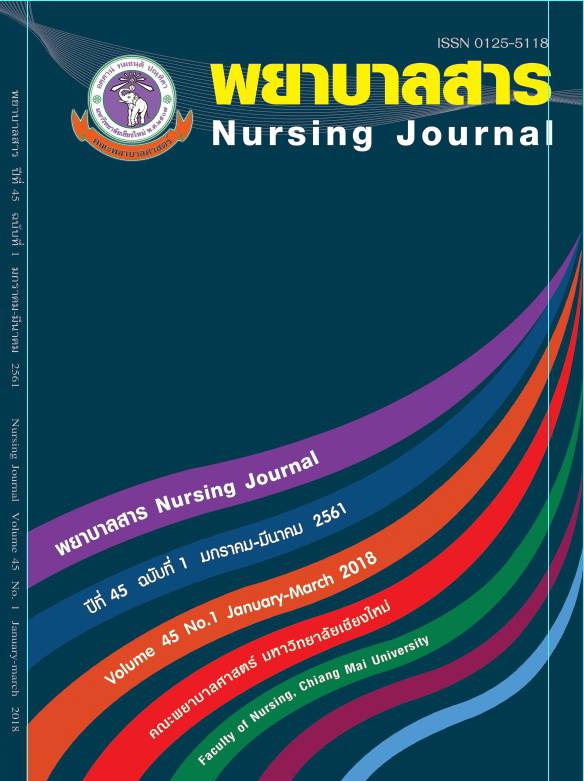ทัศนคติ บรรทัดฐานกลุ่มอ้างอิง การรับรู้การควบคุมพฤติกรรม และ ความตั้งใจต่อการเลี้ยงบุตรด้วยนมแม่ของสตรีตั้งครรภ์แรกในบังคลาเทศ
คำสำคัญ:
การเลี้ยงบุตรด้วยนมแม่, ความตั้งใจ, บังกลาเทศ, สตรีตั้งครรภ์แรกบทคัดย่อ
นมแม่ได้รับการยอมรับจากองค์การอนามัยโลกว่ามีคุณค่าทางโภชนาการต่อการเจริญเติบโตของเด็กและสร้างภูมิต้านทานของร่างกายการวิจัยครั้งนี้เป็นการวิจัยเชิงพรรณนาหาความสัมพันธ์ มีวัตถุประสงค์เพื่อศึกษาทัศนคติ บรรทัดฐานกลุ่มอ้างอิง การควบคุมพฤติกรรมตามการรับรู้และความตั้งใจต่อการเลี้ยงบุตรด้วยนมแม่ของสตรีตั้งครรภ์แรกในบังคลาเทศ กลุ่มตัวอย่างเป็นสตรีตั้งครรภ์แรกจำนวน 120 ราย ที่มาฝากครรภ์โรงพยาบาลวิทยาลัยการแพทย์โคมิลลา ประเทศบังกลาเทศ ระหว่างเดือนเมษายน 2558 ถึงเดือน พฤษภาคม 2558 เครื่องมือที่ใช้ในการวิจัยประกอบด้วยแบบสอบถามเรื่องทัศนคติ บรรทัดฐานกลุ่มอ้างอิง การควบคุมพฤติกรรมตามการรับรู้ และความตั้งใจต่อการเลี้ยงบุตรด้วยนมแม่ ซึ่งผู้วิจัยใช้เครื่องมือของ เจนเก้ และทำการแปลย้อนกลับ หาความเชื่อมั่นโดยค่าสัมประสิทธิ์อัลฟาครอนบาคได้ค่าเท่ากับ .79 วิเคราะห์ข้อมูลโดยใช้สถิติเชิงพรรณนา ผลการศึกษาพบว่า
- กลุ่มตัวอย่างสตรีตั้งครรภ์แรกร้อยละ 54.17 มีคะแนนทัศนคติด้านบวกต่อการเลี้ยงบุตรด้วยนมแม่สูงกว่าค่าเฉลี่ย
- กลุ่มตัวอย่างสตรีตั้งครรภ์แรกร้อยละ 81.70 ระบุบุคคลที่ตนเองใส่ใจความคิดเห็นต่อการเลี้ยงบุตรด้วยนมแม่ได้แก่ พยาบาลในโรงพยาบาล ร้อยละ 52.50 ระบุแพทย์ และร้อยละ 50 ระบุพ่อของลูก
-
- กลุ่มตัวอย่างสตรีตั้งครรภ์แรกร้อยละ 79.17 มีการควบคุมพฤติกรรมตามการรับรู้ในระดับสูง
- กลุ่มตัวอย่างสตรีตั้งครรภ์แรกร้อยละ 100 ระบุความตั้งใจต่อการเลี้ยงบุตรด้วนนมแม่
- ปัจจัยด้านทัศนคติ บรรทัดฐานกลุ่มอ้างอิง การควบคุมพฤติกรรมตามการรับรู้ไม่สามารถวิเคราะห์หาความสัมพันธ์กับความตั้งใจต่อการเลี้ยงบุตรด้วยนมแม่ได้ เนื่องจากกลุ่มตัวอย่างทั้งหมดเลือกคำตอบความตั้งใจด้วยการเลี้ยงบุตรด้วยนมแม่
ผลการศึกษาครั้งนี้ให้ข้อมูลพื้นฐานว่ากลุ่มตัวอย่างสตรีตั้งครรภ์แรกมีความตั้งใจต่อการเลี้ยงบุตรด้วยนมแม่ ซึ่งควรมีการศึกษาติดตามการริเริ่มการเลี้ยงบุตรด้วยนมแม่ในสตรีตั้งครรภ์กลุ่มนี้ภายหลังคลอดบุตรเพื่อดูว่าความตั้งใจและการเลี้ยงบุตรด้วยนมแม่มีความสัมพันธ์หรือไม่
คำสำคัญ: การเลี้ยงบุตรด้วยนมแม่ ความตั้งใจ บังกลาเทศ สตรีตั้งครรภ์แรก
เอกสารอ้างอิง
Alwelaie, Y. A., Alsuhaibani, E. A., Al-Harthy, A. M., Radwan, R. H., Al-Mohammady, R. G., & Almutairi, A. M. (2010). Breastfeeding knowledge and attitude among Saudi women in central Saudi Arabia.Saudi Medical Journal, 31(2), 193-198.
Baby Friendly Hospital Initiative, & United Nation Children Emergency Fund. (2014). Baby friendly Hospital initiative (BFHI) is a UNICEF initiative to promote, protect and support breastfeeding. Retrieved from http://www.babyfriendly.org.hk/ en/why-breastfeed/ benefits-of-breastfeeding
Bonyata, K. (2011). Partial weaning & combination feeding.Retrieved from
http://kellymom. com/ages/weaning/wean-how/weaning-partial/
Chertok, I. R., Luo, J., Culp, S., & Mullett, M. (2011). Intent to breastfeed: A population-based perspective. Breastfeeding Medicine, 6(3), 125-129. doi:10.1089/bfm.2010.0013
Donath, S., & Amir, L. H. (2000). Rates of breastfeeding in Australia by stat and socio economic status: Evidence from the 1996 national health survey. Journal of Pediatric Child Health,
36, 164-168.
Dorea, J. G. (2012). Policy statements on breastfeeding and human milk: Additional comments.
Journal of the American academy of pediatrics, 130 (2), 1-5.doi:10.1542/ peds. 2012- 1647D.
Haider, R., Ashworth, A., Kabir, I., & Huttly, S. R. A. (2000). Effect of community based peer
counselors on exclusive breastfeeding practices in Dhaka, Bangladesh: A randomized controlled trial. Lancet, 356(9242), 1643-1647.
Janke, J. R. (1994). Development of the breastfeeding attrition prediction tool.Journal of Nursing Research, 43(2), 101-104.
Janke, J. R. (2008). Breastfeeding attrition prediction tool.School of nursing and health sciences. University of Alaska Anchorage
Joshi, A., Amadi, C., Meza, J., Aguirre, T., & Wilhelm, S. (2015). Comparison of socio-
demographic characteristics of a computer based breastfeeding educational intervention among rural hispanic women. Journal of Community Health, 40(5), 993-1001.doi:10.1007/s10900-015- 0023-3
Kafulafula, U. K., Hutchinson, M. K., Gennaro, S., Guttmacher, S., & Kumitawa, A. (2013).
Exclusive breastfeeding prenatal intentions among HIV-positive mothers in Blantyre, Malawi: A correlation study. BMC Pregnancy and Childbirth, 13, 203-215. doi:10.1186/1471-2393-13-203
Khoury, A. J., Moazzem, S. W., Jarjoura, C., Carothers, C., & Hinton, A. (2005). Breastfeeding
initiation in low-income women: Role of attitudes, support, and perceived control. Women’s Health Issues, 15(2), 64-72. doi:11016/j.whi.2004.09.003
Kramer, M. S., & Kakuma, R. (2002).The optimal duration of exclusive breastfeeding a systematic review.1, 1- 52.Retrieved from
http://www. who.int/nutrition/publications/optimal duration_
Lauer, J. A., Betrán, A. P., Victora, C. G., de Onís, M., & Barros, A. J. D. (2004). Breastfeeding patterns and exposure suboptimal breastfeeding among children in developing countries: Review and analysis of national representative surveys. BMC Medicine, 2, 26-54. doi:10.1186/1741-7015/2/26
Lawrence, R. M., & Lawrence, R. A. (2011). Breastfeeding: more than just good nutrition.
Pediatrics in Review, 32(7), 267-280. doi:10.1542/pir.32-7-267
McLeod, S. (2009).Attitudes and behavior. Retrieved from http://www.simplypsychology.org/ attitudes.html
Mihrshahi, S., Lchikawa, N., Shuaib, M., Oddy, W., Ampon, R., Dibley, & M. J. . . . Peat, J. K. (2007). Prevalence of exclusive breastfeeding in Bangladesh and its association with diarrhea and acute respiratory infection: Results of the multiple indicator cluster survey 2003. Journal
of Health Population and Nutrition, 25(2), 195-204.
Newby, R., Brodribb, W., Ware, R. S., & Davies, P. S. W. (2014). Infant feeding knowledge, attitudes, and beliefs predict antenatal intention among first-time mothers in Queensland. Breastfeeding Medicine, 9(5), 266-272. doi:10.1089/bfm.2014.0012
Pandey, D., Sardana, P., Saxena, A., Dogra, L., Coondoo, A., & Kamath, A. (2015). Awareness and attitude towards breastfeeding among two generations of Indian women: a comparative study. PLoS One, 10(5), e0126575. doi:10.1371/journalpone.0126575
Persad, M. D., & Mensinger, J. L. (2008). Maternal breastfeeding attitudes: Association with breastfeeding intent and socio-demographics among urban primiparas. Journal of Community Health, 33(2), 53-60. doi:10.1007/s10900-007-9068-2
Polit, D. F., & Hungler, B. P. (1999). Nursing research: Principles and methods (6th ed). Philadelphia: Lippincott.
Sperber, A. D. (2004). Translation and validation of study instruments for cross- cultural research.American Gastroenterology Association, 126(Suppl. 1), s124-s128.doi:10.1053/j. gastro.2003.10.016.
Szwajcer, E. M., Hiddink, G. J., Koelen, M. A., & van Woerkum, C. M. J. (2005). Nutrition-related information-seeking behaviors before and throughout the course of pregnancy: Consequences for nutrition communication. European Journal of Clinical Nutrition, 59(1), S57-S65. doi:10.1038/sj.ejcn.1602175
Teklehaymanot, A. N., Hailu, A. G., & Wossen, B. A. (2013).Intention of exclusive breast
feeding among pregnant women using theory of planed behavior in Medebay Zana district, Tigray Region, north Ethiopia. Public Health Research, 3 (6), 126-168.
Thomas, J. S., Yu, E. A., Tirmizi, N., Owais, A., Das, S. K., Rahman, & S. . . . Stein, A. D.
(2015). Maternal knowledge, attitudes and self-efficacy in relation to intention to exclusively breastfeed among pregnant women in rural Bangladesh.Journal of Maternal Child Health, 19(1), 49-57. doi:10.1007/s 0995-014,1494-z
Walingo, M. K., & Mutuli, L. A. (2014). Influence of maternal beliefs, attitude, and perceived behavior on breast- feeding among post-partum mothers in Western Kenya. Pakistan Journal of Nutrition, 13 (5), 250- 254.
Wang, W., Lau, Y., Chow, A., & Chan, K. S. (2013). Breastfeeding intention, initiation and duration among Hong Kong Chinese women: A prospective longitudinal study. Midwifery, 30(6), 678-687. doi:10.1016/j.midw.2013.07.015
World Health Organization.(2014). Exclusive breastfeeding. Retrieved from http://www.who.int/nutrition/ topics/ exclusive breastfeeding/en/
ดาวน์โหลด
เผยแพร่แล้ว
รูปแบบการอ้างอิง
ฉบับ
ประเภทบทความ
สัญญาอนุญาต
บทความที่ได้รับการตีพิมพ์เป็นลิขสิทธิ์ของวารสารพยาบาลสาร
ข้อความที่ปรากฏในบทความแต่ละเรื่องในวารสารวิชาการเล่มนี้เป็นความคิดเห็นส่วนตัวของผู้เขียนแต่ละท่านไม่เกี่ยวข้องกับมหาวิทยาลัยเชียงใหม่ และคณาจารย์ท่านอื่นๆในมหาวิทยาลัยฯ แต่อย่างใด ความรับผิดชอบองค์ประกอบทั้งหมดของบทความแต่ละเรื่องเป็นของผู้เขียนแต่ละท่าน หากมีความผิดพลาดใด ๆ ผู้เขียนแต่ละท่านจะรับผิดชอบบทความของตนเองแต่ผู้เดียว






